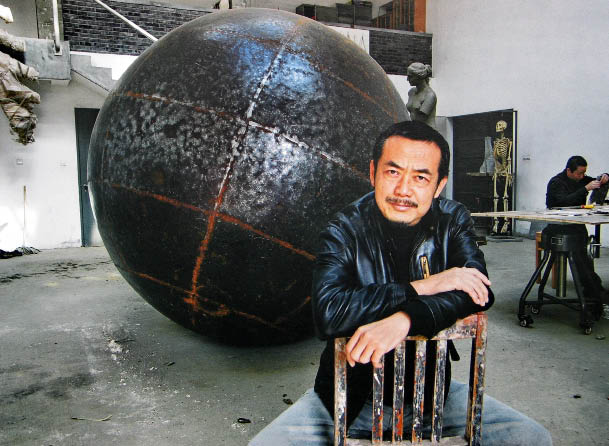Sui Jianguo: Discovering His Own Voice
By JON BURRIS
Sui Jianguo’s studio complex on the outskirts of Beijing would be the envy of any sculptor anywhere in the world. It is comprised of two large two-story joined buildings, each in the shape of a 50’×80’ rectangle, and each open to the second story and lit with skylights.
One space functions as Jianguo’s office and library. In the middle of this expansive room sits a long, massive wooden-topped, iron-legged table on wheels. It is covered with computers, printers, and high-tech equipment. Behind it, taking up three quarters of a single wall from floor to ceiling, are bookshelves completely filled with magazines and catalogs. Around the room there are three more modern-styled work tables each holding stacks of pencil drawings, printouts of computer renderings, and scale models of ongoing projects.
At the far end of the room in one corner there is a contrasting setting of Art Deco-styled leather sofas, club chairs, and antique Chinese furniture. On the walls in this corner hang drawings dating back to the 1980s and posters for a number of Jianguo’s exhibitions around the world.
The adjoining building is accessed through two huge metal doors that open into a large work space. This is clearly the production studio; there are over-sized plaster and clay models of classical figurative sculptures, a life-sized human skeleton, and what looks like dinosaur vertebra hanging from a ceiling winch. Assistants sitting at tables are busy filing sheet metal pieces and assembling them into maquettes.
Occupying the center of the room is an eight-foot-tall iron ball, a companion to a 12-foot model that formed part of an installation entitled Motion/Tension that was exhibited in September, 2009 at the Today Art Museum, Beijing. The combination of classically-influenced sculpture and modern abstract work seems rather anachronistic but couldn’t be more representative of Jianguo’s broad-ranging interests as an artist. In fact, it is what makes it difficult to place him in comparison artistically and chronologically to other artists of his generation. To a Western audience, he is perhaps best known for his Legacy Mantle series.
“Everyone refers to these works as Mao jackets,” Jianguo says, “but they were influenced by Sun Yat-sen’s original design known as the Zhongshan suit. I visited Sun Yat-sen’s hometown in Guangdong Province in 1996 and took home a brochure on the history of the suit, which of course became identified with Mao during the ‘cultural revolution.’ A year later I got the idea of sculpting the empty suit jacket when I was visiting Australia and heard people joke that all Chinese wore the same clothes and ate the same food! The mistake about artists of my generation is believing that we were only influenced by the ‘cultural revolution.’ We were aware of history before that time and there were many cultural icons from which to draw influence.”
Jianguo received a Master’s degree from the Central Academy of Fine Arts in Beijing in 1989 and went on to become a most influential director of the Department of Sculpture at the Academy, a position he has recently relinquished. He acknowledges that he lived through “the most interesting of times artistically” but didn’t discover his own “voice” until 2005, when his work became more conceptual and he realized that the generation of students he was teaching needed to develop their own language.
Today Jianguo is pushing Chinese sculpture further, exploring ideas involving time and space and how audiences interact with art in a series he calls The Shape of Time. However, he has not abandoned one of his early series that references the slogan “Made in China.” In fact, he wants to patent the use of it: “Throughout the 1960s, everything was ‘Made in Japan;’ in the 1970s ‘Made in Taiwan;’ and in the 1980s ‘Made in China.’ We are now ‘capitalists’ and this is the most iconographic symbol we have.”
 |
|
Sui and his Motion/Tension, 2009. |
